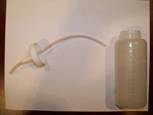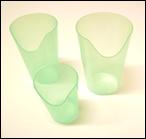Question & Answer - Feeding, Eating, & Drinking
How can you easily transition your child with low muscle tone or cerebral palsy from breast or bottle feeding to straws and open cups? An oral sensory-motor perspective.April 2014 |
|||
|
Answered by Debra A. Beckman, MS, CCC-SLP, Speech Language Pathologist, Oral Motor Specialist in Maitland, Florida For many children with sensory-motor delays due to low muscle tone or cerebral palsy, the journey from breast or bottle to new utensils such as a cup or straw can be challenging. As your child attends daycare, preschool, and then kindergarten, he or she will be expected to drink independently, as most daycare and school staff have limited time to assist children during snacks and lunch. Drinking enough (i.e., hydration) during the day is very important for the health of all children. By working together with your feeding therapist, you can help to make this journey toward independence easier for your child. Why would using new drinking utensils be difficult? For most children, it is no problem. But, children with oral sensory-motor impairments need to develop the sensory awareness and muscle control to open the jaw and close the lips around the cup or straw. They also need to control the lips, cheeks, and tongue to draw the fluid into the mouth while coordinating breathing and swallowing. That is a big task! Often, children with mild oral sensory-motor impairments have steady but slow weight gain. However, the real problems emerge when it is time to transition to new food types and utensils such as those used for drinking. TEACHING DRINKING First, it is important to find the utensil that is easiest for your child to use for drinking as you and your feeding therapist work to change your child’s muscle control. Then, you and your therapist can help your child learn to drink from any utensil, or no utensil - for example - at the water fountain.
To drink independently from a regular straw in an open container, like a cup, your child needs to have a bit more control:
To drink independently from a regular cup, your child also needs:
When teaching drinking from a straw or cup, never push or force your child’s head back during this process. This is dangerous and can cause choking. It is important for your child’s head to be in good alignment with his or her body. As the fluid is presented, using any utensil, it is helpful to pace the timing of each sip, by counting out loud 1 – 2 – 3, as the fluid is moving into the mouth. At the count of “3,” stop the flow of fluid into the mouth to cue the child to swallow and then breathe before the next sip. TEACHING OPEN CUP DRINKING
Place the cup rim gently against your child’s upper lip while waiting for the lower lip to lift up to seal against the cup rim. If the lower lip does not rise to meet the cup, tilt the cup so the liquid touches the upper lip. This will usually encourage the lower lip to lift up to the cup with the tongue staying inside the mouth, not sticking out under the cup. Practice this technique a little every day until your child is drinking several ounces. Next, encourage your little one to place his or her hands around the cup with yours and practice until there is enough control to permit complete independence. And there you have it, a successful developmental milestone accomplished! SUMMARY To improve your child’s oral control, you and your feeding therapist can work together in therapy and outside of mealtime using Beckman Oral Motor Interventions (if your therapist knows these) along with specific feeding techniques. As you and your child work together with your therapy team, day by day, your child can develop the sensory awareness and muscle control needed to drink easily from anything, even from a water fountain. Thank you for this opportunity to answer this question. I hope the answer is helpful to you and your child. More information about oral sensory-motor patterns and Beckman Oral Motor Assessment and Intervention can be found on my website http://www.beckmanoralmotor.com/. Contact Information: Beckman & Associates, Inc. 620 N Wymore Road, Suite 230 Maitland, FL 32751 407-647-4740 |
|||

 The easiest drinking utensil is a flexible straw in a closed container, a straw bottle. There is a
The easiest drinking utensil is a flexible straw in a closed container, a straw bottle. There is a  When your child is ready to begin drinking from an open cup (not a sippy cup), it may be helpful to use a cut-out cup. It is easy to make one out of a paper cup. Cut one side of the paper cup ½” lower than the other side, so as you tip the cup upward the cup does not hit the child’s nose. This way, your child’s head can stay level as you present the liquid. If you sit behind your child, you can better support your child’s head.
When your child is ready to begin drinking from an open cup (not a sippy cup), it may be helpful to use a cut-out cup. It is easy to make one out of a paper cup. Cut one side of the paper cup ½” lower than the other side, so as you tip the cup upward the cup does not hit the child’s nose. This way, your child’s head can stay level as you present the liquid. If you sit behind your child, you can better support your child’s head.